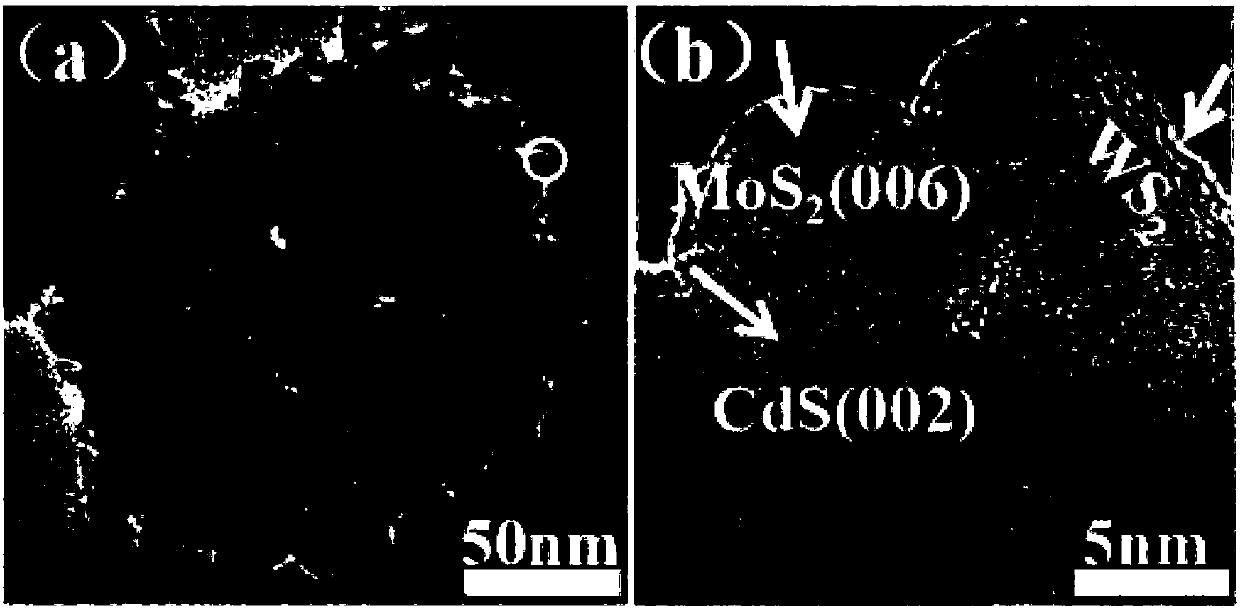Preparation method of cadmium sulfide-molybdenum sulfide-tungsten sulfide heterojunction photocatalytic composite material with urchin-like structure and application of cadmium sulfide-molybdenum sulfide-tungsten sulfide heterojunction photocatalytic composite material
A composite material and sea urchin-like technology, which is applied in chemical instruments and methods, physical/chemical process catalysts, inorganic chemistry, etc., can solve the problems of activity decline, low activity of hydrogen production by photo-splitting water, and achieve good application prospects and industrialization potential. The effect of excellent photocatalytic performance
- Summary
- Abstract
- Description
- Claims
- Application Information
AI Technical Summary
Problems solved by technology
Method used
Image
Examples
Embodiment 1
[0046] S1: To an appropriate amount of organic solvent ethylene glycol, add cadmium diethyldithiocarbamate (CED), molybdenum diethyldithiocarbamate (Mo(dedc) 5 ) and tungsten diethyldithiocarbamate (W(dedc) 6 ), fully stir with a magnetic stirrer, mix evenly, and obtain the precursor reaction solution;
[0047] S2: The precursor reaction solution is subjected to a two-stage microwave heating constant temperature reaction to obtain a cadmium sulfide-molybdenum sulfide-tungsten sulfide heterojunction photocatalytic composite material, specifically:
[0048] S2-1: under the microwave power of 200W, heat the precursor reaction solution obtained in step S1 from room temperature to 90°C, and keep at this temperature for 10 minutes to obtain the first reaction solution;
[0049] S2-2: Continue heating the first reaction solution to 160°C under a microwave power of 500W, and keep it at this temperature for 10 minutes to obtain a second reaction solution;
[0050] S2-3: naturally coo...
Embodiment 2-5
[0051] Embodiment 2-5: the investigation of raw material consumption ratio
[0052] In addition to using different mass ratios of cadmium diethyldithiocarbamate (CED) and molybdenum diethyldithiocarbamate (Mo(dedc) 5 ) and tungsten diethyldithiocarbamate (W(dedc) 6 ) except that other operations are the same as in Example 1, so that Embodiment 2-5 has been carried out, and the used raw material consumption ratio and composite material nomenclature are shown in Table 1 below.
[0053] Table 1. Composite materials prepared under different raw material dosage ratios
[0054]
Embodiment 6-9
[0055] Example 6-9: Investigation of the end temperature of two-stage microwave heating
[0056] Embodiment 6-9: Except using the endpoint temperature shown in the following table 3 in step S3-3, other operation is all the same as embodiment 1, thereby carried out embodiment 6-9, the endpoint used and composite material nomenclature see Table 3 below.
[0057] Table 3. Composites prepared at different endpoint temperatures
[0058]
PUM
 Login to View More
Login to View More Abstract
Description
Claims
Application Information
 Login to View More
Login to View More - R&D
- Intellectual Property
- Life Sciences
- Materials
- Tech Scout
- Unparalleled Data Quality
- Higher Quality Content
- 60% Fewer Hallucinations
Browse by: Latest US Patents, China's latest patents, Technical Efficacy Thesaurus, Application Domain, Technology Topic, Popular Technical Reports.
© 2025 PatSnap. All rights reserved.Legal|Privacy policy|Modern Slavery Act Transparency Statement|Sitemap|About US| Contact US: help@patsnap.com



